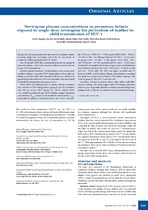Nevirapine plasma concentrations in premature infants exposed to single-dose nevirapine for prevention of mother-tochild transmission of HIV-1

View/
Date
2011Author
Mugabo, Pierre
Els, Ilse
Smith, Johan
Rabie, Helena
Smith, Peter
Mirochnick, Mark
Steyn, Wilhelm
Hall, David
Madsen, Richard
Cotton, Mark F.
Metadata
Show full item recordAbstract
Background: No pharmacokinetic data exist for premature infants receiving single-dose nevirapine (sd NVP) for prevention of mother-to-child transmission (MTCT) of HIV.
Aim: To describe NVP decay pharmacokinetics in two groups of premature infants – those whose mothers either received or did not receive NVP during labour. Methods: Infants less than 37 weeks’ gestation were prospectively enrolled. Mothers received sd NVP during labour if time allowed. Infants received sd NVP and zidovudine. Blood was collected on specified days after birth and NVP concentrations were determined
by liquid chromatography-mass spectrometry. Results: Data were obtained from 81 infants, 58 born to mothers who received sd NVP during labour (group I) and 23 to mothers who did not receive NVP (group II). Of the infants 29.6% were small for gestational age (SGA). Median (range) maximum concentration (Cmax), time to reach maximum concentration (Tmax), area under the plasma concentration-time curve (AUC) and halflife (T½) were 1 438 (350 - 3 832) ng/ml, 25h50 (9h40 - 83h45),
174 134 (22 308 - 546 408) ng×h/ml and 59.0 (15.4 - 532.6) hours for group I and 1 535 (635 - 4 218) ng/ml, 17h35 (7h40 - 29h), 168 576 (20 268 - 476 712) ng×h/ml and 69.0 (22.12 - 172.3) hours for group II. For group II, the median (range) volume of distribution (Vd) and body clearance (Cl) were 1 702.6 (623.7 - 6 189.8) ml and
34.9 (6.2 - 163.8) ml/h. The AUC was higher (p=0.006) and Cl lower (p<0.0001) in SGA infants. Plasma concentrations exceeding 100 ng/ml were achieved over 8 days in 78% infants in group I and 70.0% in group II. The MTCT rate was 4.8%. Conclusion: Women in preterm labour often deliver with little advance warning. Our study suggests that NVP dosing of preterm infants as soon as possible after birth without maternal intrapartum dosing may be as effective as combined maternal and infant dosing.
